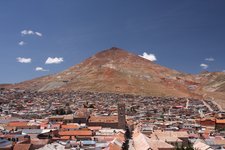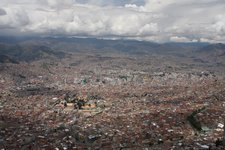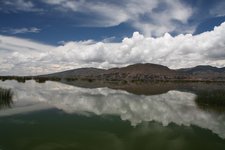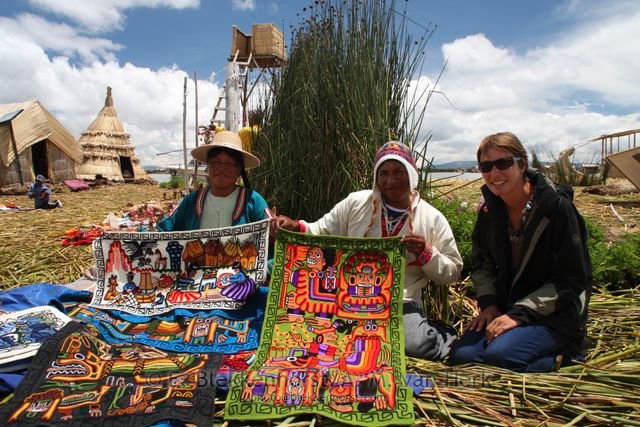There are 12 species of coca. Coca is traditionally cultivated in the lower altitudes of the eastern slopes of the Andes. It is widely consumed by the Andean peoples of Peru, Colombia, Ecuador, Venezuela and Bolivia. It’s used to overcome fatigue, hunger and thirst. It is also used as an anesthetic to alleviate pain. The Incas are believed to have used coca as an anesthetic when performing brain surgery (success rate figures vary..). It is considered particularly effective against altitude sickness. Having had some troubles with the altitude, we know now that coca indeed does help wonderfully. Chewing the leaves is not recommended as it is basically filthy. But drinking maté de coca (tea) or sucking on coca candy (an acquired taste) helps your lungs to absorb more of the little oxygen there is and, wow, your headache is gone…
Potosí (elev. 4,090 m) is considered to be the highest city in the world. For 300 years it was incredibly important to the Spanish for its Cerro Rico (Rich Mountain) with its enormous amount of silver ore. It is said that the amount of silver extracted was enough to build a silver bridge between Potosí and Spain and still have plenty left. Many Indians and Africans were used as slaves and some 8 million of them died because of the hard and dangerous work in the mines. Some say that with their bones you could build a bridge between Potosí and Spain… Walking around town with its steep cobble stone streets was not easy. Even after being at higher altitudes for a while now our lung capacity simply was not sufficient so we got tired quickly and we kept gasping for air. We were looking forward to descend (in a shared taxi this time) to a mere 2750 meters, the altitude of the city of Sucre. It is the constitutional capital of Bolivia and seat of the Supreme Court. The historic colonial centre (a UNESCO World Heritage Site since 1991) is very nice to explore and the view from La Recoleta, especially at sun set, is stunning. One of the nearby attractions is the Parque Cretácico Cal Orck’o, a place where you can see the world’s largest collection of dinosaur tracks. More than 60 million years ago dinosaurs left their footprints in muddy flats which surfaced when a cement factory recently dug up the area. Very cool.
Not looking forward to another very long bus ride, we flew from Sucre to La Paz (elev. 3,640 m) which gave us a beautiful view of the Altiplano, the high plateau (average elev. 3300 m) of the Andes. The city, which is the administrative capital of Bolivia, was built in a canyon created by the Choqueyapu River and the view from the ridge of the Altiplano is absolutely stunning. It’s a big crowded city and nowhere near as pretty as Sucre. But it was fun to walk around in and to try one of Bolivia’s specialty snacks: the salteña. It’s a type of empanada and, hmm, certainly not my favorite. Karin liked it very much and went for another round when we were at La Paz’s best salteñaria. From La Paz we did an interesting tour to Tiwanaku (Tiahuanacu), an archeological site West of La Paz and not far from Lake Titicaca. The Tiwanaku are considered an important pre-columbian culture and one of the most important precursors to the Inca Empire. On the way back we got to visit, yet another, Valle de la Luna with weird rock formations. The coca museum is also very nice. It gives an interesting, albeit a little biased, view on the coca leaf. And, woohoo, they sell some good coca candy.. 🙂
From La Paz we took the bus to Copacabana, the main but small town on the Bolivian shores of Lake Titicaca. The lake (elev. 3,812 m) is the largest in South America and one of the highest commercially navigable lakes in the world. After we arrived, we visited one of the nearby islands, Isla del Sol. The island has many ruins dating back to the time of the Inca Empire. In the religion of the Incas, it was believed that the sun god was born here. After a short city tour and an exhausting (sorry guys for dragging you up there) walk up the hill (4,100 m, the Mont Blanc with its 4,810 m is for wimps) for some nice views of Copacabana and the lake, it was time, unfortunately, to say goodbye to Karin (snif, snif). Her 2 weeks and a bit of vacation were over so she had to go back to La Paz to fly home. Thanks K. It was fun having you with us! Together with Marinda (whom we met on the Uyuni tour and who decided to tag along) we took the bus on to Puno, Peru. Puno (elev. 3,860 m) is a town on the other, Peruvian, side of the lake. A bit bigger than Copacabana, more crowded but fun. Especially since there’s a festival going on with traditional music and dance. From here you can easily visit the famous Uros Floating Islands. The Uros Indian tribe decided a long time ago to leave the shores of the lake to permanently live on artifically created floating islands made of reed. It’s a bit weird to walk around on but nice to visit Uros families in their homes and learn about their way of life. Okay, you’re expected to buy some souvenirs as well but what the heck…
 |
 |
 |


